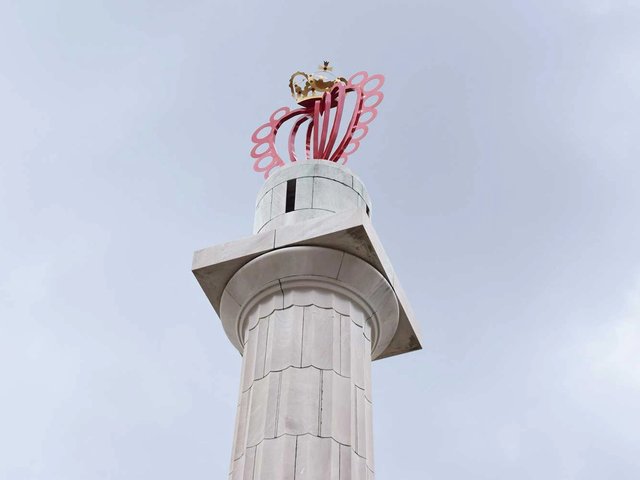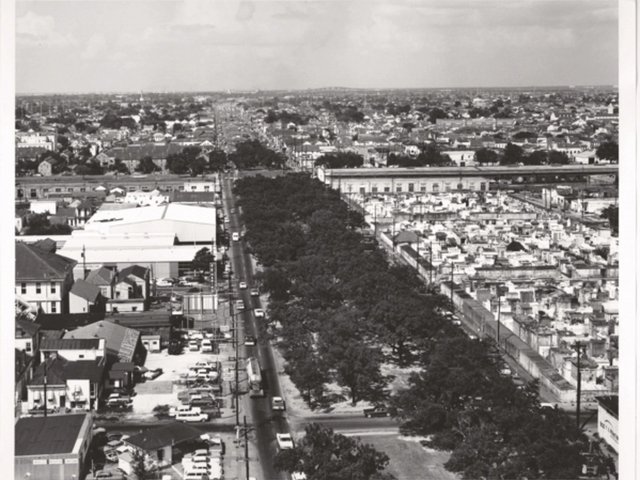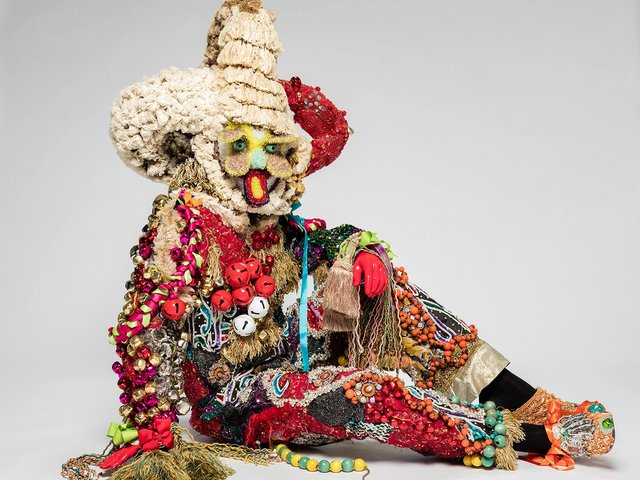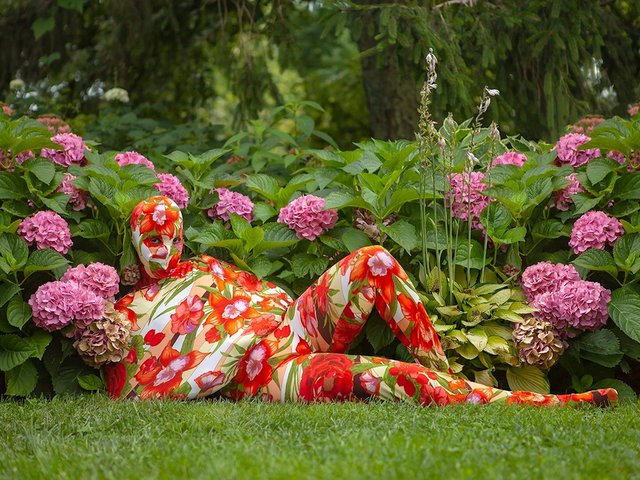Prospect New Orleans, the city’s contemporary-art triennial, was launched (as a biennial) to be an engine of growth and recovery from what was until earlier this month the costliest natural disaster in US history. Under its founding director, Dan Cameron, Prospect’s purpose was “to reinvigorate the city, a historic regional artistic centre, following the human, civic and economic devastation of Hurricane Katrina”.
The curator Miranda Lash and the artist Ebony G. Patterson, co-artistic directors of the exhibition’s sixth edition, have put a timely and powerful spin on that founding mission. What if New Orleans is not a city in need of rescuing—from natural disasters, from institutional racism, from environmental exploitation, from housing crises, from political corruption or, most recently, from a terror attack—but is actually a model of resiliency? What if cities that are relatively new to cataclysmic environmental disasters, like New York and Los Angeles, have something fundamental to learn from New Orleans?
“This framework postulates New Orleans as already living in the future,” Patterson said during one of the exhibition’s opening events last autumn. Lash concurred: “We want to show New Orleans as a gift and as a scout.” The title of Lash and Patterson’s exhibition, The Future Is Present, The Harbinger Is Home (until 2 February), reflects this reframing of New Orleans as a city where the future of climate catastrophe and historical reckoning that so much of the world is grappling with is already present, and where people are at home amid harbingers of precarity and change.
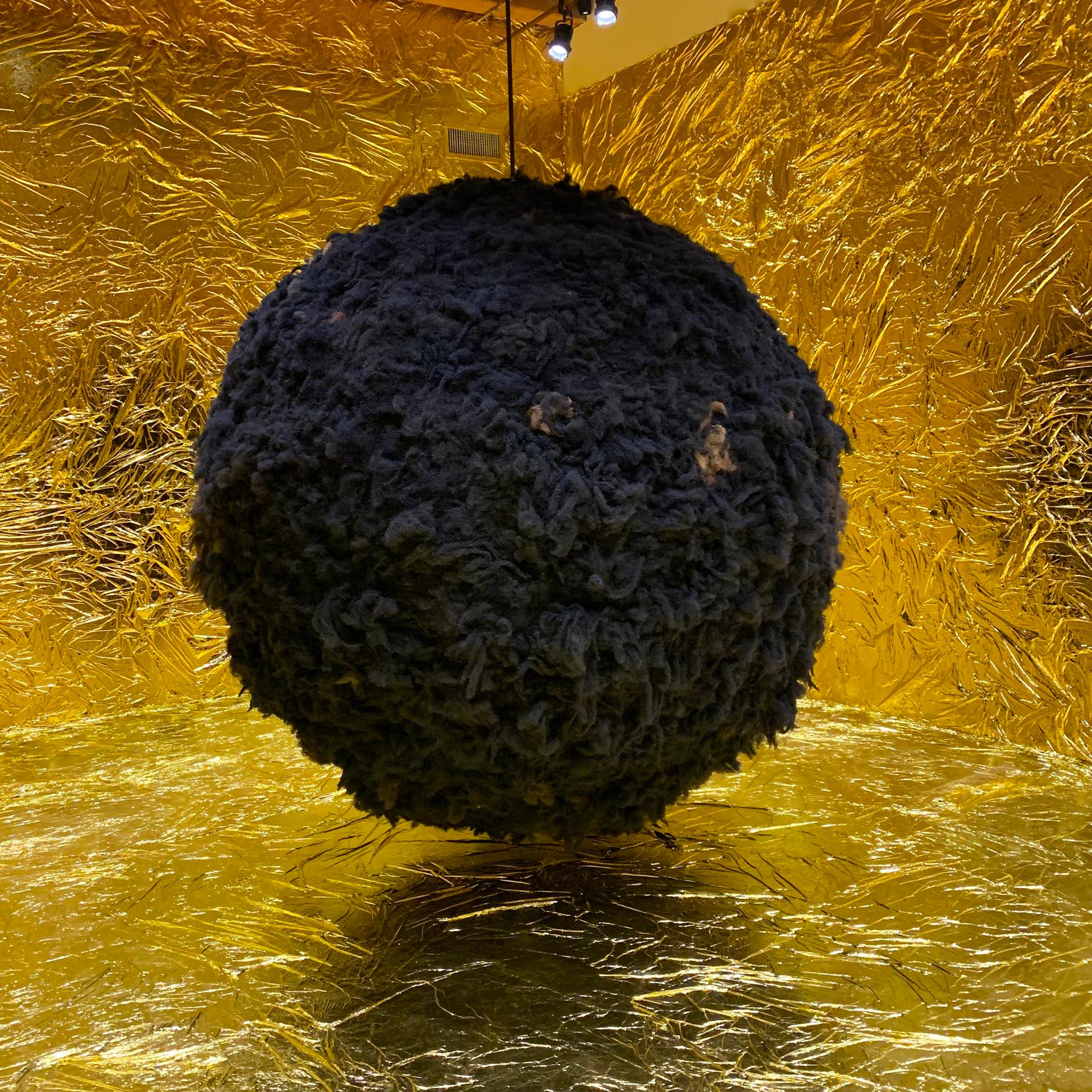
Jeannette Ehlers, We're Magic. We're Real #2, 2020/24 Benjamin Sutton
The exhibition features 51 artists spread across 21 venues and sites around the city. Its strongest works grapple directly with the issue of adaptability, not only in the context of New Orleans but in other parts of the world dealing with the brunt of climate change, the destructiveness of extractive industries and the deeply entrenched aftereffects of colonialism—from Los Angeles and Hanoi to Copenhagen and Port-au-Prince. Collectively, they demonstrate how contemporary art and exhibitions like Prospect can function less as engines of recovery and more as engines of coping—a more pragmatic and meaningful mandate for people living in places facing similar challenges to New Orleans, which the curators point out is a growing share of the world’s population.
“New Orleans is often positioned within a language of exceptionalism with phrases like ‘There’s no place like it’,” Lash and Patterson write in the exhibition guide. “We argue that, in many ways, New Orleans reflects how most of the world lives.”
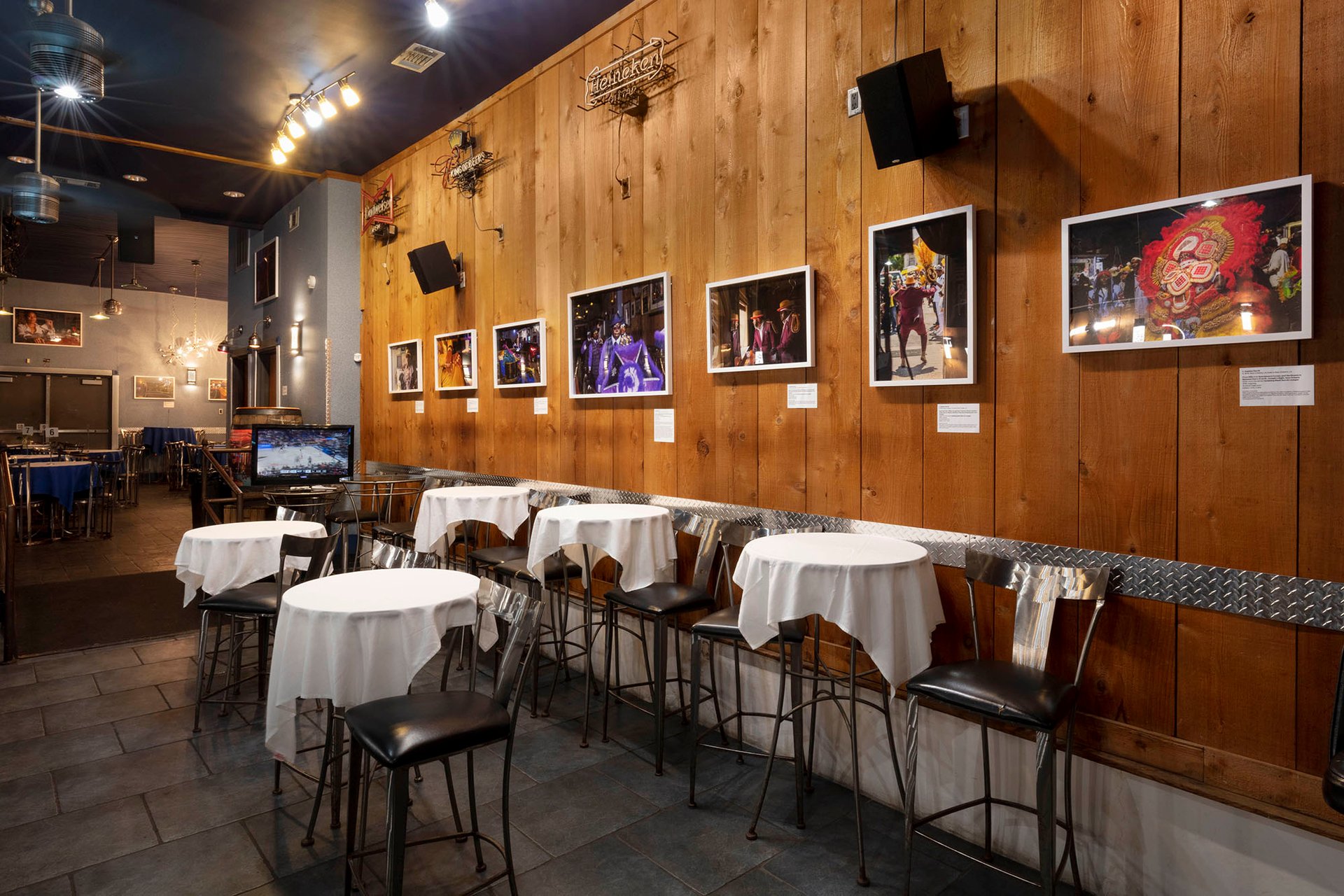
Photos from L. Kasimu Harris's series Vanishing Black Bars & Lounges (2018-present) on view at Sweet Lorraine's Jazz Club Photo by Jonathan Traviesa
Several of the participating artists get at the exhibition’s themes of adaptability and endurance through archival and documentary projects. L. Kasimu Harris, one of the nine featured artists who are based in New Orleans, has been documenting the city’s Black-owned bars for the better part of a decade as gentrification has pushed many of them to shutter. Images from his series Vanishing Black Bars & Lounges (2018-present) are on view at the Ogden Museum of Southern Art and in one of the bars he photographed, Sweet Lorraine's Jazz Club, a fixture on St Claude Avenue for more than 30 years. At a panel the week of the opening, Harris said: “My work is about declaring: ‘I was here, I am here and I will be here.’”
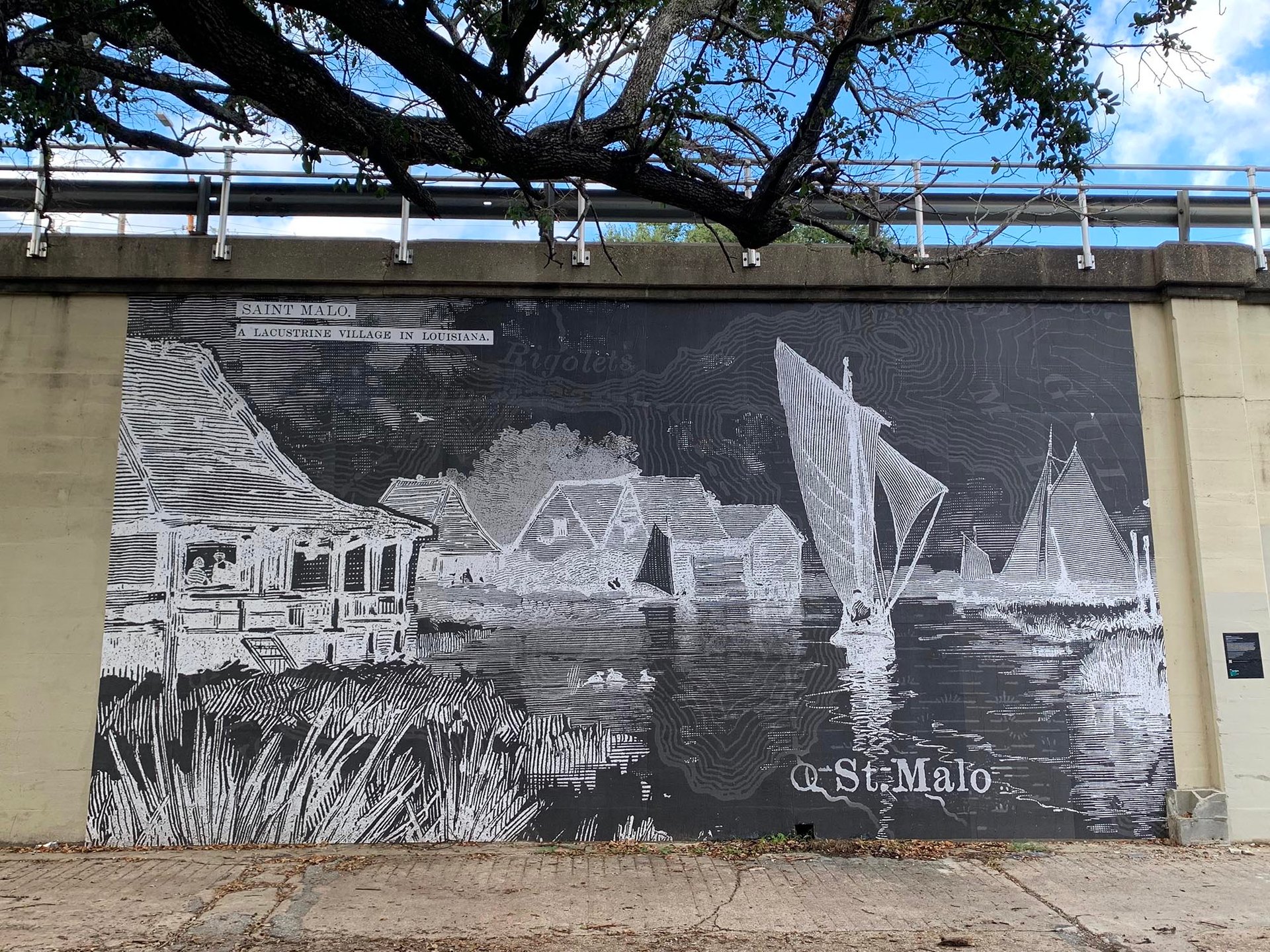
Stephanie Syjuco's mural Phantom Visions (The Lacustrine Village of St. Malo)
(2024) at Music Box Village Benjamin Sutton
A similarly declarative claim to place and time is at the root of Stephanie Syjuco's project for Prospect. The Manila-born, Oakland-based artist’s large black-and-white mural at the Contemporary Arts Center and four outdoor sites, Phantom Visions (The Lacustrine Village of St. Malo) (2024), depicts the community of St Malo, Louisiana, the first permanent Filipino settlement in the US. Established in the 18th century by Filipino sailors and escapees of Spanish ships, the community was occupied until the 20th century, but its former site southeast of New Orleans has largely disappeared due to coastal erosion. Syjuco’s image is based on illustrations of St Malo published in Harper’s Weekly in 1883, which she has rendered at a monumental scale. Like Harris’s project, Syjuco’s murals preserve and carry a resilient community into the future, even if only as documentation.
Putting down roots
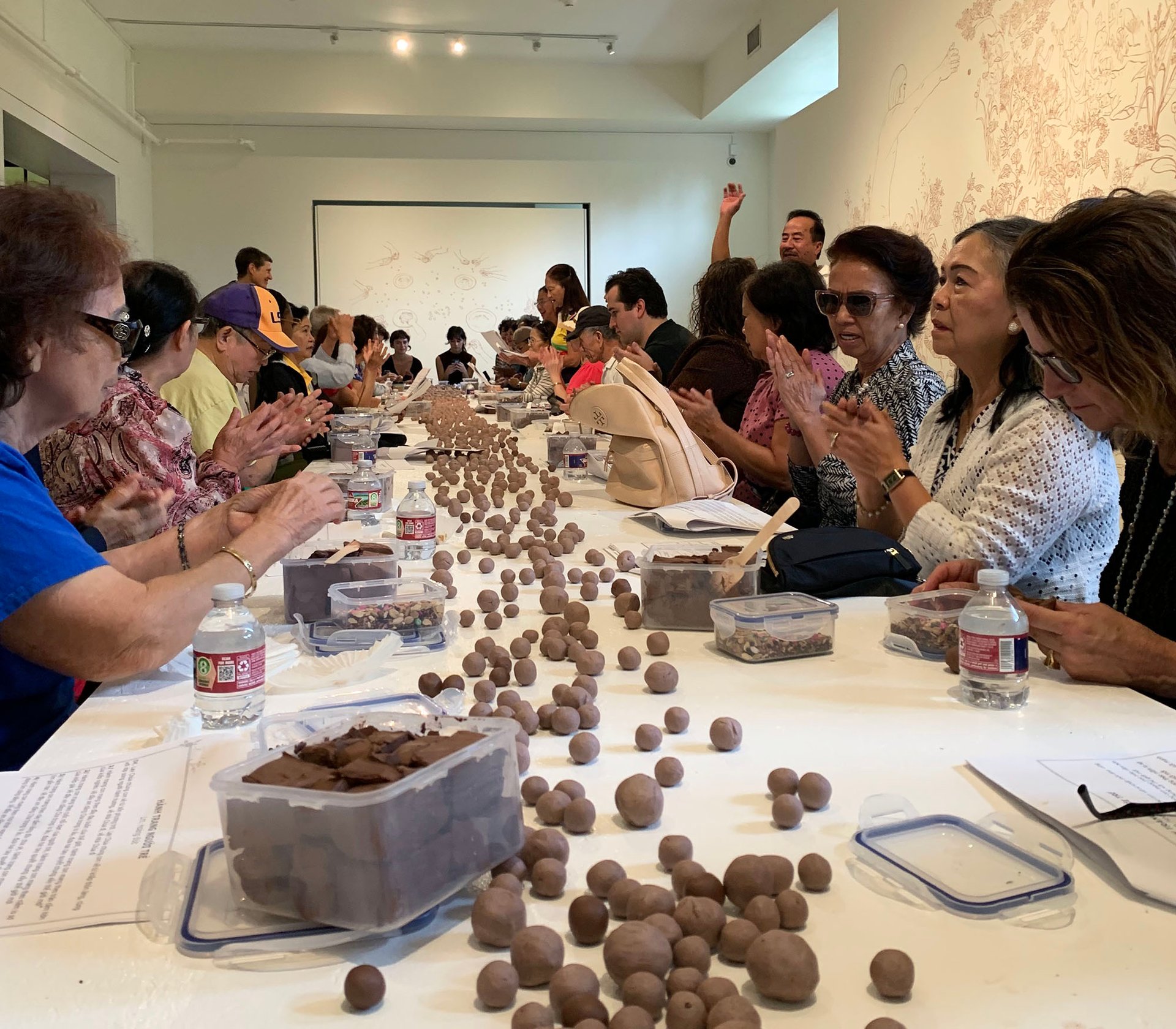
A seed-ball workshop with elders from New Orleans's Vietnamese community as part of Tuan Mami's collaborative project Seeding the Future (2024) at Xavier University of Louisiana Art Gallery Benjamin Sutton
The Hanoi-based artist Tuan Mami's Prospect project, which centres New Orleans’s large Vietnamese diaspora, takes a poetic approach to community building and preservation. His exhibition at the Xavier University of Louisiana Art Gallery includes video interviews with first-generation Vietnamese New Orleanians as well as the interactive installation Seeding the Future (2024).
Visitors are invited to sit with elders from the Vietnamese community and roll pinches of seeds into balls of clay. Once the clay hardens, the balls can be used to transport and ultimately plant the seeds which, with some persistent watering, will sprout. The act of gathering around the gallery’s long table to talk, sing and pack seeds—including various types of rice, beans, corn and squash—is another way of practicing resilience, of preserving memories, recipes, stories and songs, all while seeding new connections and plantings. (Another contribution by a Vietnamese artist, Tuấn Andrew Nguyễn's exquisite two-channel musical video Amongst the Disquiet, on view at the New Orleans Museum of Art's sculpture-garden pavilion, focuses on a Vietnamese American family’s grief for a dead loved one as a way to address intergenerational dynamics and the experiences of loss and alienation that are the shared inheritances of immigrants everywhere.)
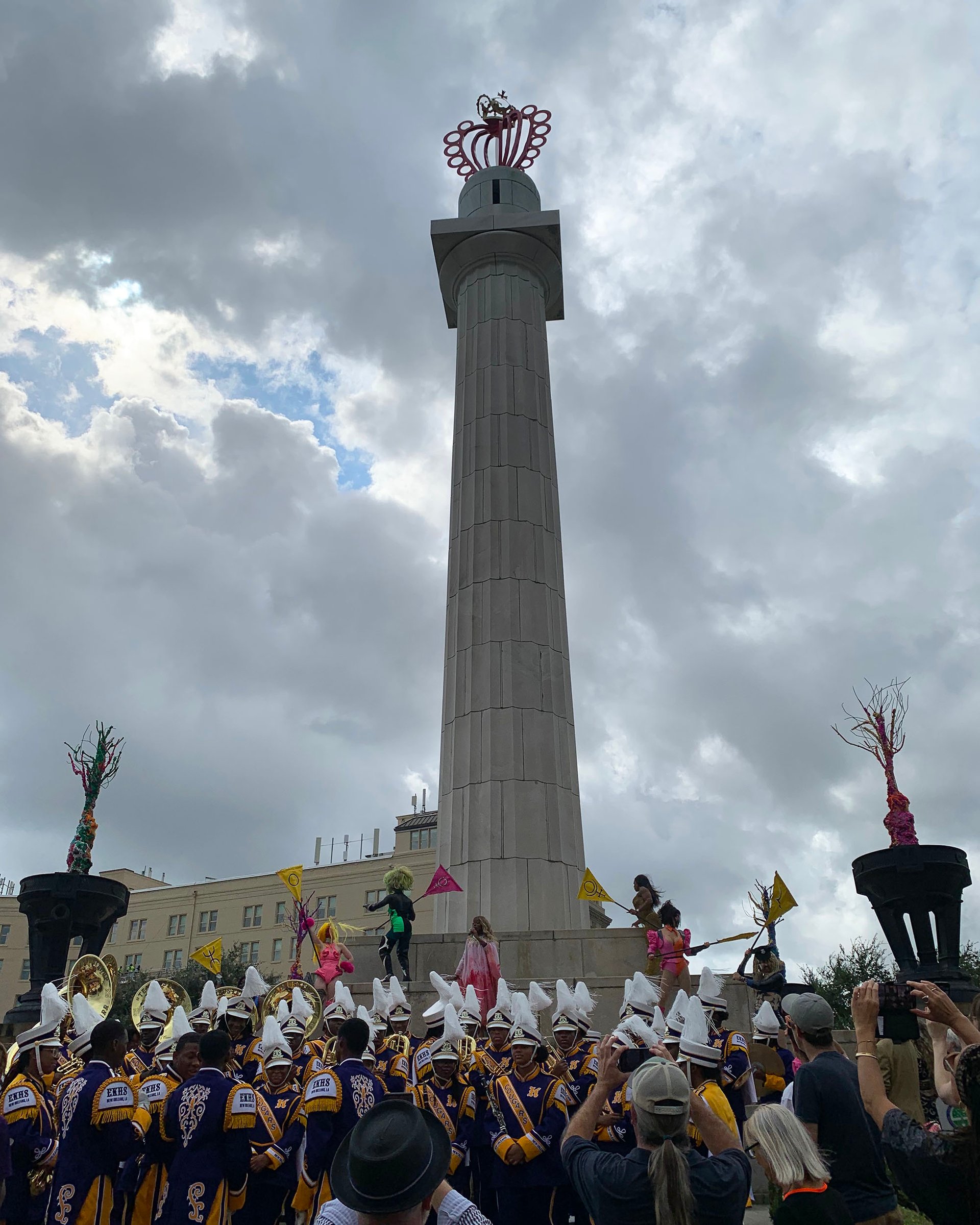
Members of the Edna Karr High School marching band and the Choke Hole queer wrestling troupe perform at the foot of Raúl de Nieves's The Sacred Heart of Hours and the Trees of Yesterdays, Today, and Tomorrow (2024) in Harmony Circle Benjamin Sutton
Other Prospect artists use historical context as a point of departure for projecting stories of belonging and resilience into the near and distant future. Perhaps most literally, the Mexico-born, New York-based artist Raúl de Nieves has transformed the vacant pedestals of a former Confederate monument into a tribute to New Orleans’s queer and Latinx communities. A crowned heart atop the monument’s marble column references Mexican folklore and Catholic iconography, while four surrounding pedestals hold trees fashioned from Mardi Gras beads provided by the city’s first all-women Mardi Gras krewe. A Prospect kick-off event included performances at the monument by the Edna Karr High School marching band and members of the Choke Hole queer wrestling troupe, symbolically reclaiming a site long associated with white supremacy for queer communities and communities of colour.
The New Orleans-born artist Ashley Teamer is also using public art to reclaim part of the city’s built environment. Her sculpture at Lemann Park & Playground in Tremé, Tambourine Cypress (2024), is a steel tree that functions as a communal percussion instrument, with embedded cymbals, wind chimes and tambourines. Sited within view (and earshot) of the infamous Claiborne Expressway, whose construction bisected the oldest Black neighbourhood in the US, it is intended as a beacon to activate an in-between space and reconnect communities.
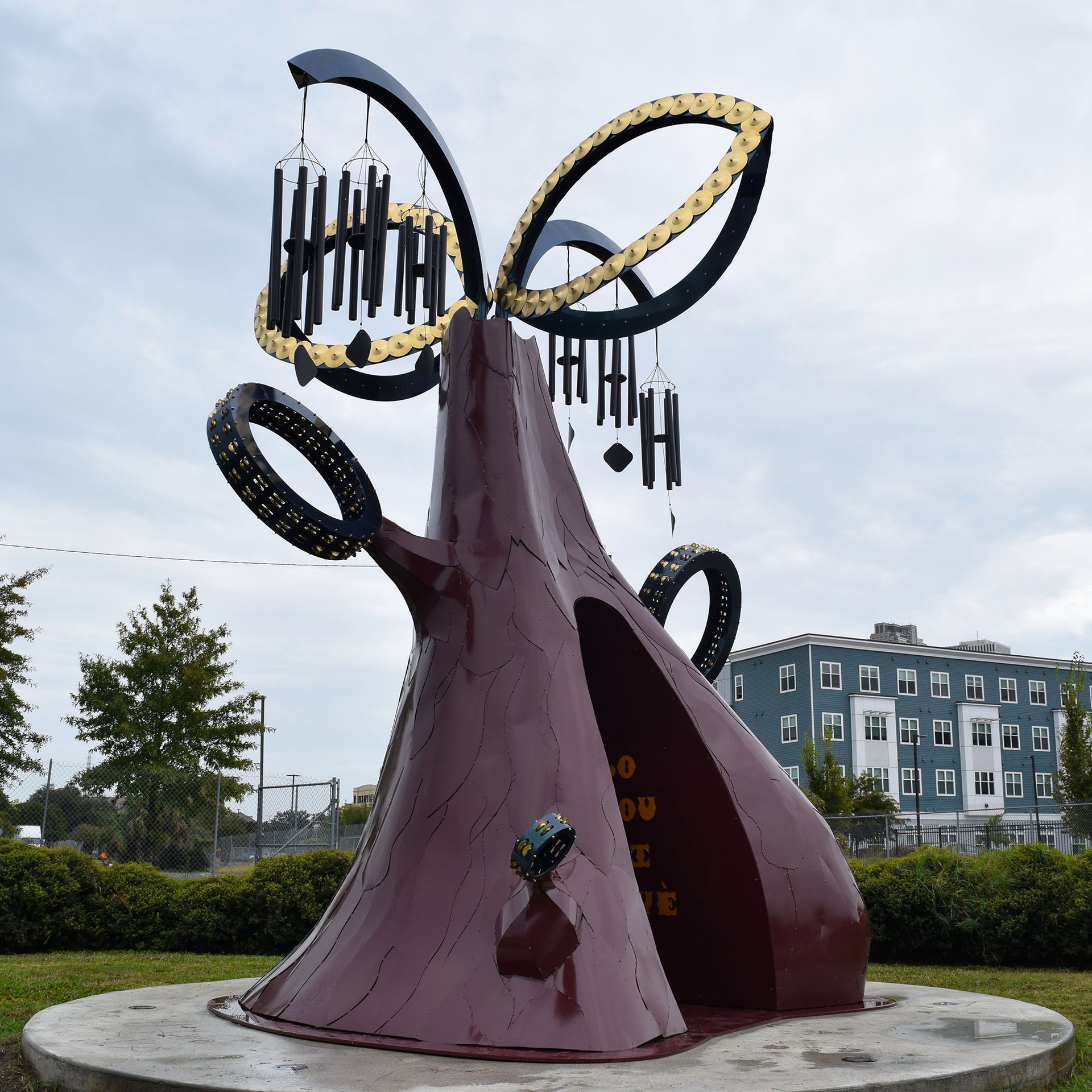
Ashley Teamer's Tambourine Cypress (2024) at Lemann Park & Playground Benjamin Sutton
“I knew that if I made something near this highway, it had to be useful,” Teamer says. “My task as an artist is to imagine possible and impossible futures—I’m imagining a future where the Claiborne Expressway is gone.” In a related pair of photo collages on view at the Ogden and featuring images of Claiborne Avenue distorted and stitched together in the shape of butterfly wings, Teamer envisions the oppressive elevated expressway turned inside out and into a community gathering space.
Facing the future with science fiction
Imagined futures figure prominently at Prospect’s most distinctive venue this year, a former Ford Motor Plant along the banks of the Mississippi River just across the county line in neighbouring Arabi. It is home to some of the exhibition’s largest sculptures and installations, including Proposals for Loops in Linear Time, a collaboration between the New York-based artist Zalika Azim and the Los Angeles-based artists rafa esparza and Dewey Tafoya that marries futuristic and ancient iconography—and one icon from a galaxy far, far away.
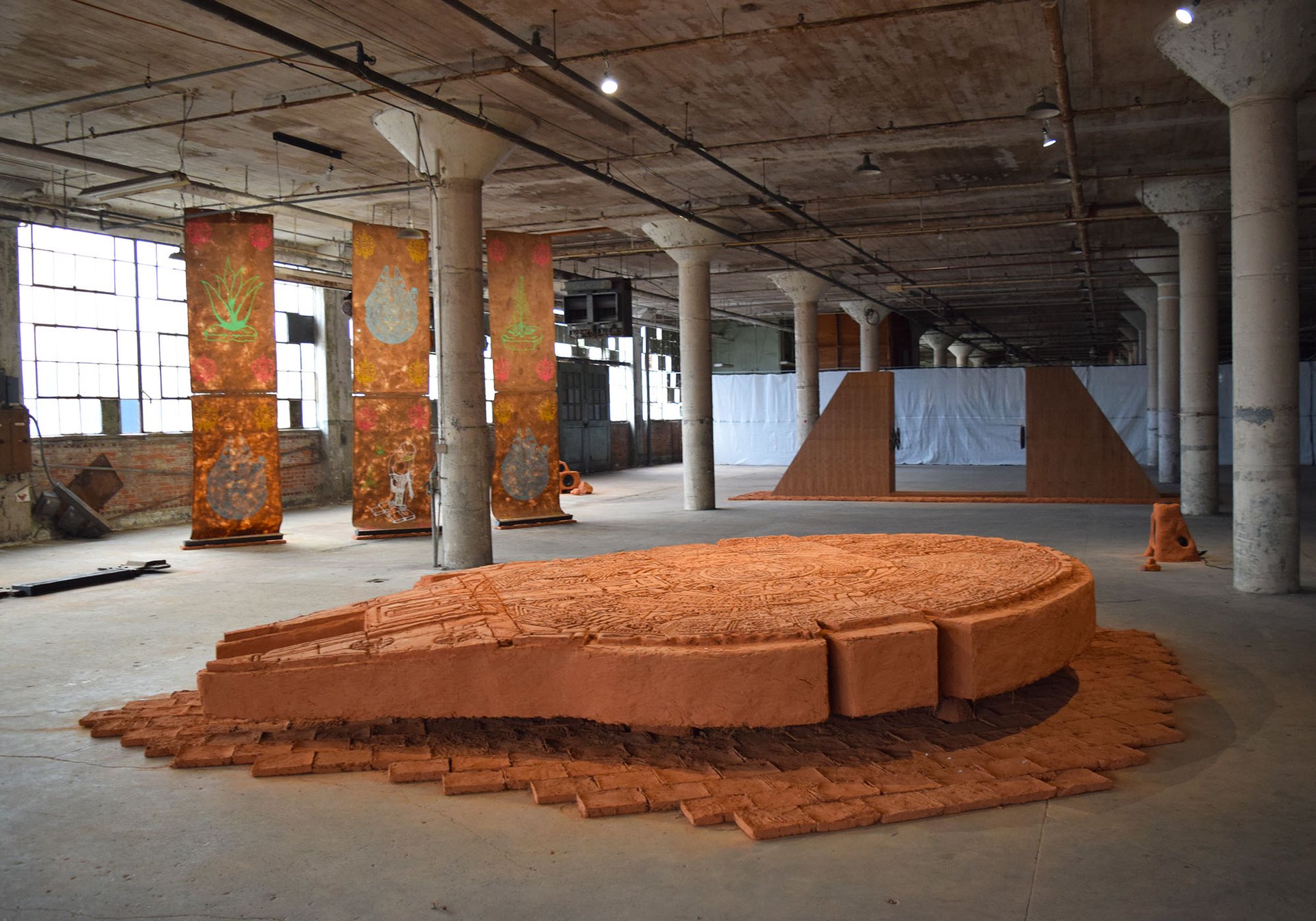
Works by Zalika Azim (back right), rafa esparza (foreground) and Dewey Tafoya (back left) in Proposals for Loops in Linear Time at the Ford Motor Plant Benjamin Sutton
A replica of the famous Star Wars vessel the Millennium Falcon, esparza’s Mexica Falcon after Dewey Tafoya (2024) has been fashioned from adobe made of locally sourced Mississippi clay and stamped with ancient Aztec iconography. It is flanked by Tafoya’s towering scrolls of amate, a bark-based paper that has been in production in Mexico for millennia (and was banned by Spanish colonisers), printed with related imagery referencing pre-colonial agriculture and Chicano identity. Azim’s kinetic sculpture nearby features two jump ropes attached to electric motors, perpetually swinging in a double-dutch configuration. The work alludes to both the Millennium Falcon’s ability to make the “jump” into hyperspace, travelling across space and time, as well the ancient Phoenician and Egyptian origins of jumping rope. The Afrofuturist installation reminds visitors that much of the knowledge necessary to transcend our current cultural, environmental and political crises is readily available and often ancient in origin.
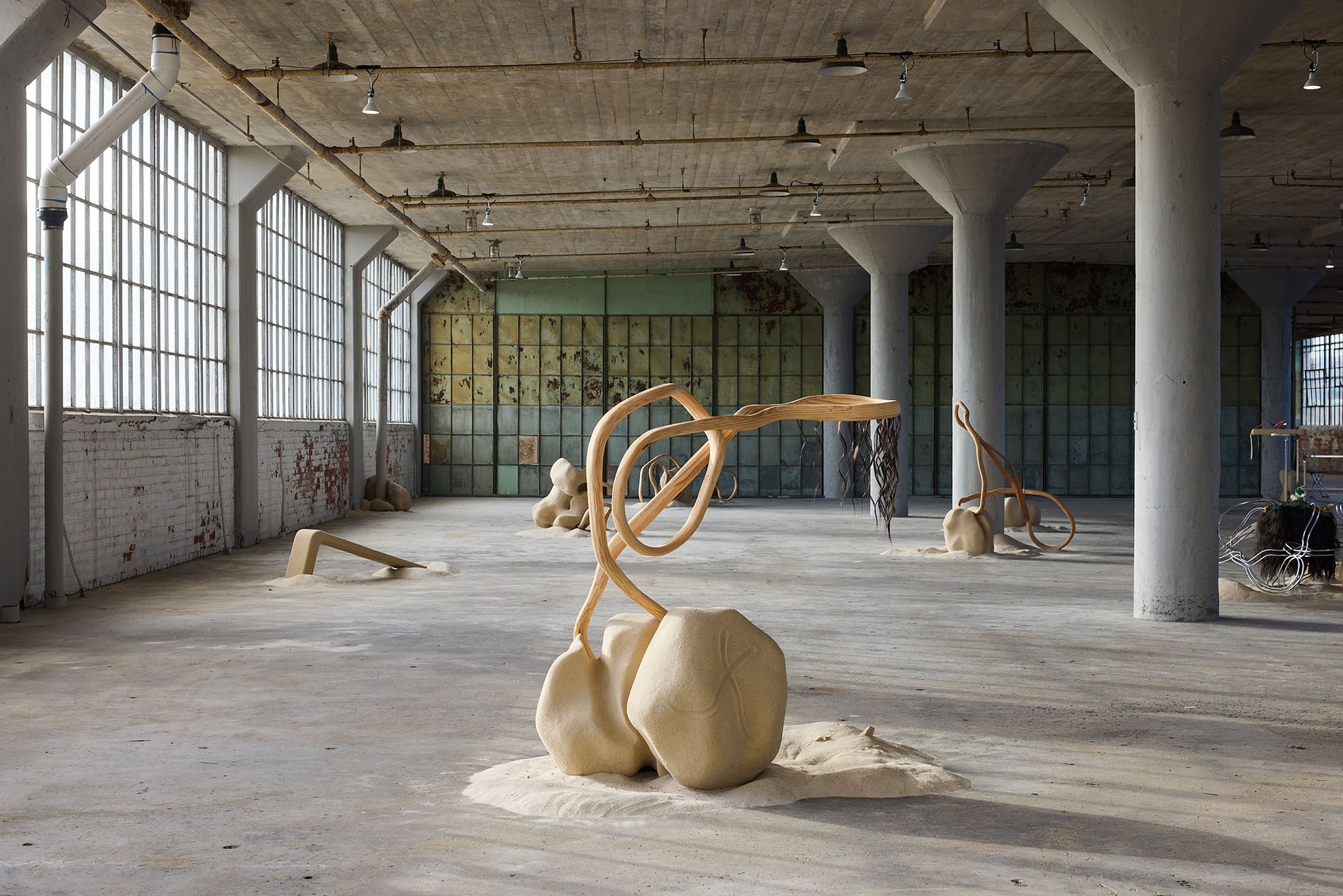
Blas Isasi, 1,001,532 CE, 2023-24 Photo by Alex Marks
On the Ford Motor Plant’s upper level, the Lima-born, New Orleans-based artist Blas Isasi's installation 1,001,532 CE (2023-24) imagines a futuristic, post-human version of the Peruvian landscape. It projects an event from 1532—the bloody Cajamarca Massacre, which occurred shortly after the first contact between the Spanish and the Inca, and ultimately led to the collapse of Peru’s pre-Columbian civilisation—one million years into the future. Isasi’s group of sculptures melds elements of Peru’s environments (the sand of its coast, the rocks and minerals of the Andes and the wood of the Amazon) into abstracted, otherworldly forms that evoke wind-carved rock, driftwood and desert plants. Some also feature hair extensions, clay, foam and other materials that bring them to life, suggesting future beings formed from raw materials.
Stirring landscapes
A similar kind of elemental awakening plays out at the Historic New Orleans Collection in the French Quarter, where the Haiti-born, Philadelphia-based artist Didier William has created an installation of new paintings and sculptures titled Gesture to Home. The works are inspired by the cypress trees of the Atchafalaya Basin, the largest swamp and wetland in the US, located to the west of New Orleans. Unlike William’s best-known works, the paintings here are devoid of humanoid figures, and the region’s distinctive bald cypresses take the starring role. In the adjacent sculptures, covered in the artist’s trademark eye patterns, the cypresses’ trunks sprout human figures.
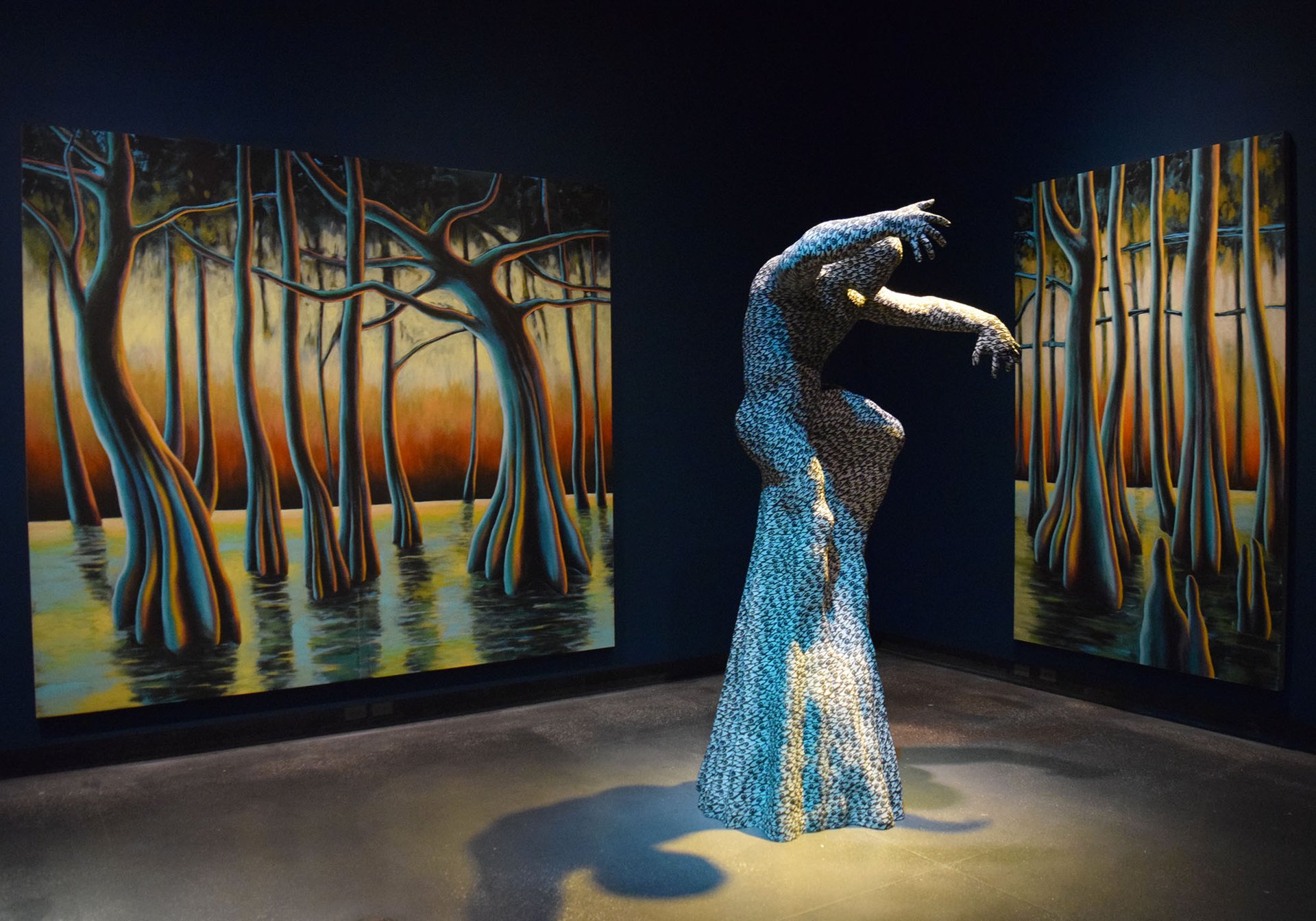
Partial view of Didier William's installation Gesture to Home (2024) at the Historic New Orleans Collection Benjamin Sutton
For William, the installation connects the country where he was born to the one where he lives now, alluding to the Louisiana Purchase—whereby the US roughly doubled in size, acquiring New Orleans and other French territories—and its connection to the Haitian Revolution, which precipitated Napoleon’s divestment of France’s biggest colonial holdings in the Americas. “A lot of these cypress trees are more than 1,000 years old and have borne witness to this history,” he says. He adds that the works are about “what it means for displaced people when returning to their homeland becomes impossible”.
That problem—looming for the billions who live in places that regularly suffer drought, flooding, wildfires, hurricanes, heat waves and any other manner of natural disaster that is being made more frequent and forceful by human-caused climate change—is taken up repeatedly by the artists in Lash and Patterson’s exhibition. One of the most evocative instances is another post-human landscape, this one at the Contemporary Arts Center.
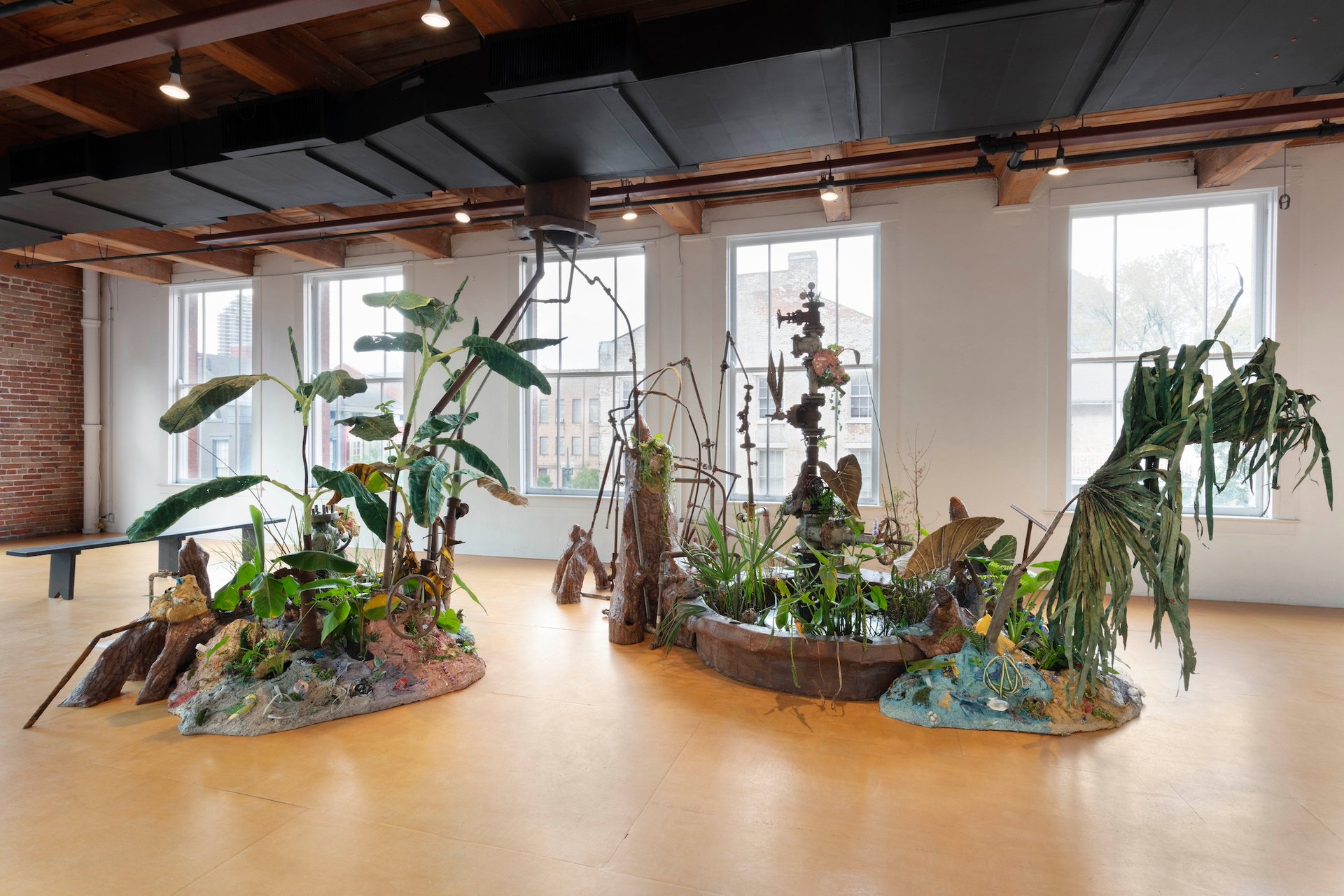
Hannah Chalew, Orphan Well Gamma Garden, 2024 Photo by Jonathan Traviesa
The Baltimore-born, New Orleans-based artist Hannah Chalew has transformed one of the often forgotten features of Louisiana’s landscape, oil and gas infrastructure, into the basis for an indoor fountain. Her installation Orphan Well Gamma Garden (2024) is fashioned from a material she calls “plasticane”—a mix of shredded plastic waste and bagasse, the byproduct of processing sugarcane into juice—and also includes a salvaged oil wellhead, plants native to southern Louisiana and the artist’s custom scent, dubbed Fertile Rot, which is based on the odour of the gasses generated by swamps.
The artist has pointedly emblazoned the base of the wellhead with the words “Helis Oil & Gas”, a reference to an oil and gas extraction company based in New Orleans whose non-profit arm, the Helis Foundation, is a major funder of the arts in Louisiana (and one of the biggest supporters of this edition of Prospect, though crucially not of Chalew’s commission). “Our economy is so entrenched in the oil and gas industries, but so is our culture,” Chalew said during a panel last autumn. “They’re distracting from what they’re doing rather than working to make it better.”
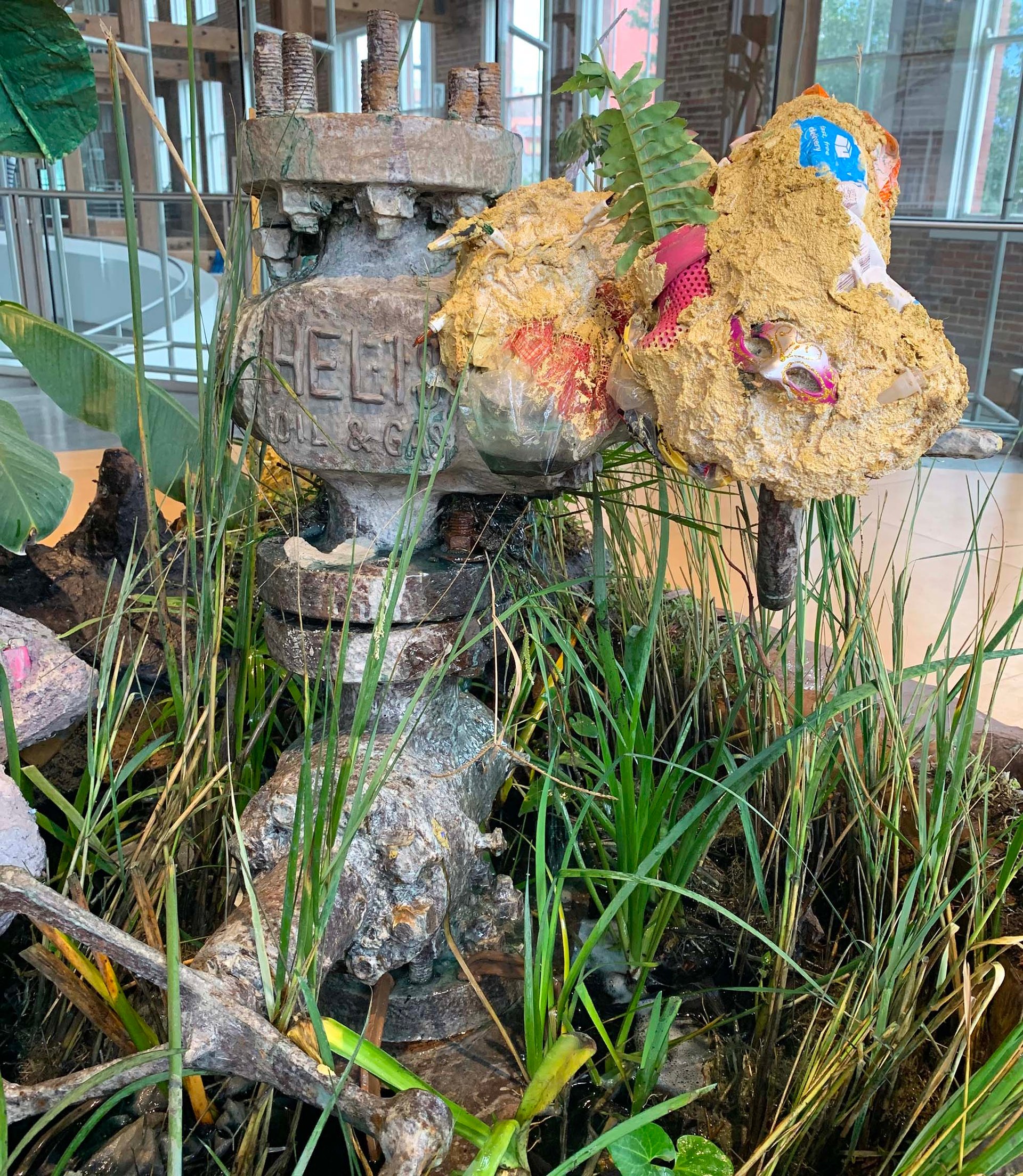
Hannah Chalew, Orphan Well Gamma Garden, 2024 (detail) Benjamin Sutton
From the artists imagining better or bleaker futures to those capturing the memories of communities past and present, there is no shortage of urgent, elegiac and buoyant work in The Future Is Present, The Harbinger Is Home. Resonant works, too numerous to fully catalogue here, also include installations by Jeannette Ehlers, Shannon Alonzo, Maia Ruth Lee, Deborah Jack, Joan Jonas, Arturo Kameya and Joiri Minaya; paintings by Thomas Deaton; and performances by Bethany Collins and the duo of Eisa Jocson and Venuri Perera. To be sure, there are also works that fail to stand out or simply don’t seem to fit the curators’ fairly elastic thematic framework (or both), but taken collectively, the widely varied elements of this edition of Prospect coalesce into a timely vision of the past, present and possible futures—with New Orleans at its centre, charting a path forward.
- Prospect.6: The Future Is Present, The Harbinger Is Home, until 2 February, various venues, New Orleans



